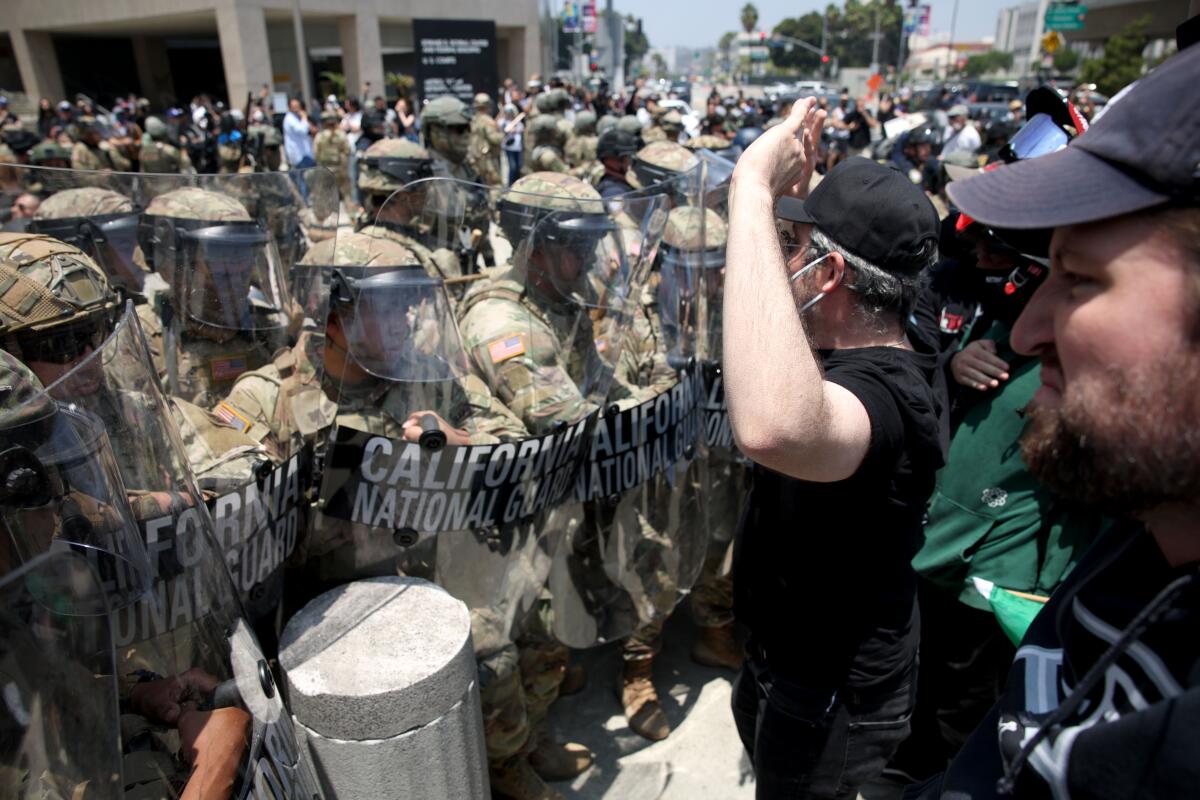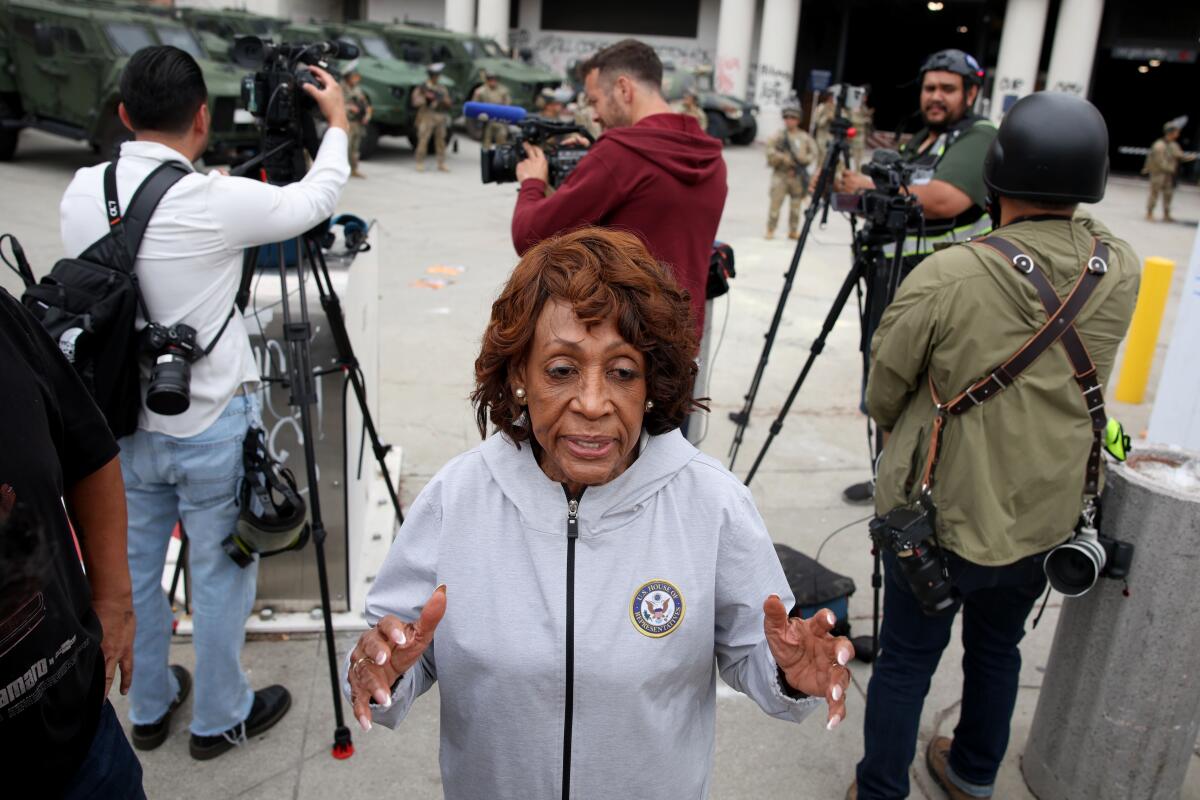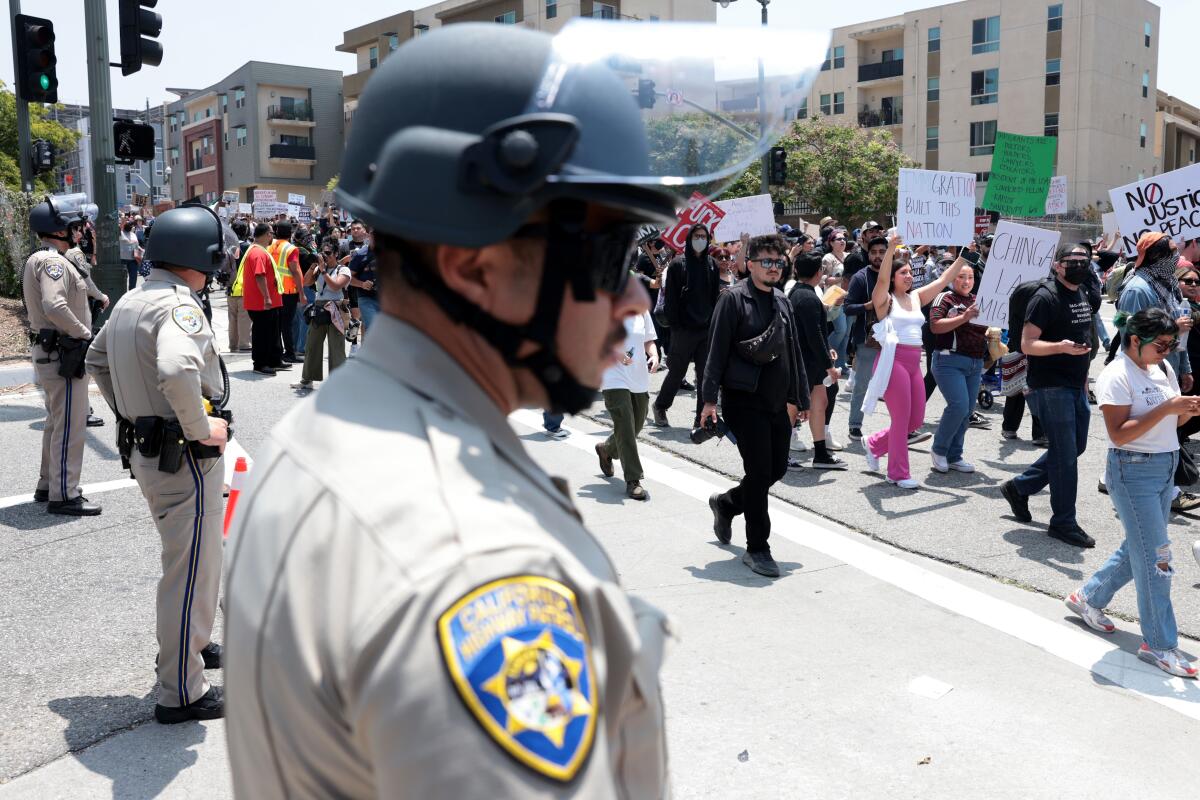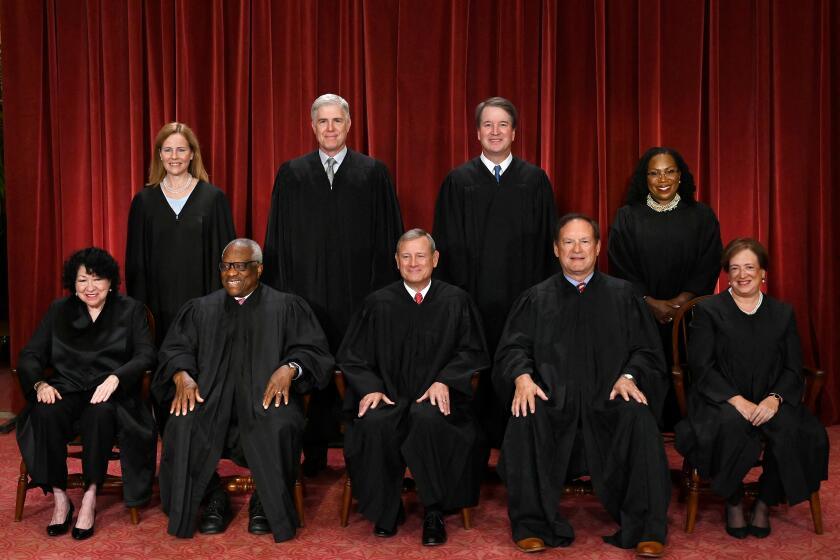National Guard arrives in Los Angeles as fallout from immigration raids continues

- Share via
California National Guard troops arrived in Los Angeles on Sunday in a show of force following scattered clashes between immigration agents and protesters and amid a widening political divide between California and the Trump administration.
The move by President Trump to activate nearly 2,000 guardsmen marked the first time since 1965 that a president has deployed a state’s National Guard without a request from that state’s governor. The decision was met with stern rebukes from state and local officials, including Gov. Gavin Newsom who said the deployment was “not to meet an unmet need, but to manufacture a crisis.”
Newsom’s office on Sunday afternoon sent a formal letter to the Trump administration asking them to rescind their deployment of troops.
“There is currently no need for the National Guard to be deployed in Los Angeles, and to do so in this unlawful manner and for such a lengthy period is a serious breach of state sovereignty that seems intentionally designed to inflame the situation, while simultaneously depriving the state from deploying these personnel and resources where they are truly required,” the letter reads.
On Sunday afternoon, there were tense moments outside a federal detention center in downtown L.A., with officers firing tear gas and less-lethal rounds at protesters.
Around 4 p.m., a swarm of protesters streamed onto the southbound side of the 101 Freeway, blocking traffic. The protesters were in a standoff with dozens of officers lined up under the Los Angeles Street bridge.
But other areas that had seen unrest over the last few days, including the Garment District, Paramount and Compton, seemed calm.
It was unclear exactly how many troops were deployed to Los Angeles as of Sunday afternoon. The National Guard’s 79th Infantry Brigade Combat Team, based in San Diego, said Sunday that 300 personnel were on the ground to protect federal property and personnel.
Trump administration officials have seized on the isolated incidents of violence to suggest wide parts of L.A. are out of control. On Sunday, Trump took to social media to claim “violent, insurrectionist mobs are swarming and attacking” federal law enforcement.
“A once great American City, Los Angeles, has been invaded and occupied by Illegal Aliens and Criminals,” he wrote, blaming Democratic politicians for not cracking down earlier.
While officials have not said how long the immigration enforcement actions will continue, Trump told reporters Sunday, “we’re going to have troops everywhere. We’re not going to let this happen to our country.”
Many California officials, who have long been at odds with Trump, say the president was trying to exploit the situation for his political advantage and sow unneeded disorder and confusion.
Los Angeles Mayor Karen Bass called the deployment of federalized troops a “chaotic escalation” and issued a reminder that “Los Angeles will always stand with everyone who calls our city home.”
While most demonstrators have gathered peacefully, some have hurled objects at law enforcement personnel, set garbage and vehicles on fire and defaced federal property with graffiti.
The Immigration and Customs Enforcement operation in Los Angeles over the past week has resulted in the arrest of 118 people, including some who have been convicted of drug trafficking, assault, child cruelty, domestic violence and robbery, according to the agency.
Assistant Secretary for Public Affairs Tricia McLaughlin and Republican politicians who support Trump’s immigration actions have characterized the protests as riots intended to “keep rapists, murderers and other violent criminals loose on Los Angeles streets.”

On Sunday morning, Rep. Maxine Waters (D-Los Angeles) addressed roughly two dozen National Guard soldiers posted outside the Metropolitan Detention Center on Alameda Street. She had arrived at the center to inquire about Service Employees International Union California President David Huerta, who was injured and detained while documenting an immigration enforcement raid in downtown Los Angeles on Friday.
“Who are you going to shoot?” Waters asked the solders. “If you’re going to shoot me, you better shoot straight.”
Remnants of tear gas used by law enforcement during protests Saturday lingered in the air around the building, at times forcing Waters to cough. Waters, an outspoken critic of the president, called the deployment of National Guard troops an unnecessary escalation of tensions and accused Trump of “trying to make an example” out of Los Angeles, a longstanding sanctuary city.
Leonard Tunstad, a 69-year-old Los Angeles resident, rode his bike up to the edge of the loading dock where troops were stationed and asked them if they really wanted to be loyal to a president that “had 34 felony convictions.” He said he felt compelled to shout facts about Trump at the guardsmen because he feared the young men have been “indoctrinated against their own citizens.”
Tunstad said he believed the deployment was a gross overreaction by the Trump administration, noting the city has been home to far more raucous protests that were handled by local police.
“This is just a show. This is just a spectacle,” he said.
A Department of Homeland Security officer approached one of the louder demonstrators saying that he “didn’t want a repeat of last night” and didn’t want to “get political.” He told protesters as long as they stick to the sidewalk and don’t block vehicle access to the loading dock there wouldn’t be any problems.
Later, DHS and California National Guard troops shoved dozens of protesters into Alameda Street, hitting people with riot shields, firing pellets into the ground and deploying tear gas to clear a path for a caravan of DHS, Border Patrol and military vehicles to enter the detention center.
Jose Longoria struggled to breathe as clouds of tear gas filled Alameda Street. He pointed to a white scuff mark on his shoe, saying that a tear gas canister had hit him in the foot, causing him to limp slightly.
“We’re not armed. We’re just peacefully protesting. They’re acting out,” Longoria said of the officers.
For the record:
8:18 a.m. June 9, 2025An earlier version of this article said incorrectly that Julie Solis was holding a Mexican flag.
Julie Solis, 50, walked back and forth along Alameda Street holding a California flag and urging the crowd to make their voices heard, but to keep the scene peaceful. She said she believes the National Guard was deployed solely to provoke a response and make Los Angeles look unruly to justify further aggression from federal law enforcement.

“They want arrests. They want to see us fail. We need to be peaceful. We need to be eloquent,” she said.
National Guard troops were last summoned to Los Angeles and other Southern California cities in 2020, during the George Floyd protests. Those deployments were authorized by Newsom.
However, the last time the National Guard was called on by a president without a request from a state governor was 60 years ago, when President Lyndon B. Johnson sent troops to Alabama to protect civil rights demonstrators.
Antonio Villaraigosa, former speaker of the California Assembly and a former L.A. mayor, said Trump’s move was “meant to incite more fear and chaos in our community.”
“Trump’s military-style mass deportation ICE raids in California have gone too far, tearing families apart and threatening public safety,” he said in a statement. “The raids at stores and workplaces are wrong, just as it’s wrong to separate families with raids at schools, graduations, and churches.”
In Paramount, a group of camouflaged National Guard troops were stationed in a business park with armored vehicles where a Department of Homeland Security office is located.
Jessica Juarez walked along Alondra Boulevard with a trash bag full of spent tear gas canisters on Sunday morning. Her voice grew hoarse as she helped a group of volunteers clean up after clashes between protesters and law enforcement the day before.
United States Attorney Bill Essayli told NBC in an interview that an officer suffered a broken wrist and others were injured by rocks and cement block pieces that were thrown at them during Saturday’s protest. He said it was “an extremely violent crowd,” but officials are “undeterred.”
An acrid odor still hung in the air from the gas and flash bang grenades law enforcement fired on protesters Saturday, while scorched asphalt marked the intersection outside a Home Depot where federal authorities had staged.
“I’m proud of our community, of the strength we showed,” said Juarez, 40. “It’s like they put so much fear into Paramount and for what? These guys didn’t even clean up after themselves.”
The images of Paramount shrouded in smoke and flanked by police in riot gear are unusual for this community of about 50,000 residents. In many ways, the city became the starting point for the escalating federal response.
“What else do you call it but an attack on Paramount and the people who live here?” said resident and union organizer Alejandro Maldonado. “People in the community were standing up to unjust immigration policies.”
For some, the fight between Los Angeles residents and the federal government is akin to David and Goliath. “It really does seem like they wanted to pick a fight with the little guy,” union organizer Ardelia Aldridge said.
Staff writers Seema Mehta, Rebecca Ellis and Brittny Mejia contributed to this report
More to Read
Sign up for Essential California
The most important California stories and recommendations in your inbox every morning.
You may occasionally receive promotional content from the Los Angeles Times.

















